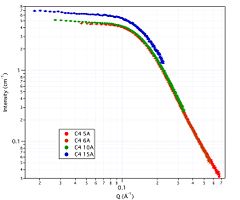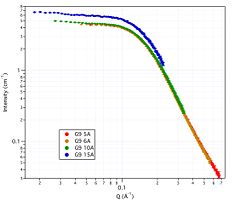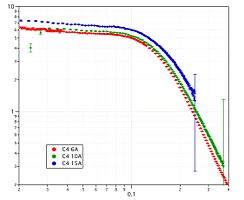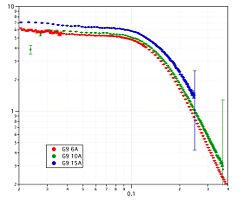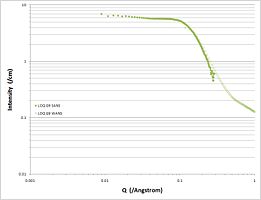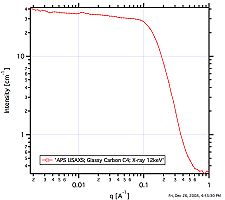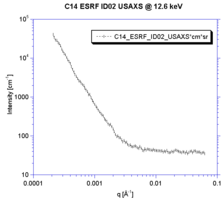Glassy Carbon Round Robin: Difference between revisions
| Line 62: | Line 62: | ||
The calibration factor was found by scanning the secondary standard and using only an unirradiated part for calibration. | The calibration factor was found by scanning the secondary standard and using only an unirradiated part for calibration. | ||
Due to the uncertainties of the sample the accuracy of the absolute calibration is not assumed to be better than +-20%. | Due to the uncertainties of the sample the accuracy of the absolute calibration is not assumed to be better than +-20%. | ||
The error bars indicate the statistical errors that are practically neglegible (typically 0.1% of the data values). | |||
<Gallery caption="ESRF ID01 PINHOLE data for C14" widths="300px" heights="200px"> | <Gallery caption="ESRF ID01 PINHOLE data for C14" widths="300px" heights="200px"> | ||
Revision as of 18:18, 2 July 2009
Samples
Two samples of glassy carbons (labeled C4 and G9) from Jan Ilavsky have made their way (as of Dec 1 2008) to NIST, ILL and ISIS and will head on to Diamond and APS. Additionally another sample, labeled G8, has been measured at ISIS.
The samples are cut from glassy carbon material, manufactured by Alpha Aesar under description: Glassy Carbon type 2. These samples are manufactured in 50 x 50 mm plates, nominally 1 mm thick. Measurements with a micrometer were all between 0.99 and 1.01 mm
Experimental details and Data
NIST
- NIST data for C4 and G9
Zip file of all data (in NIST 6 column format) with plots in PDF and Igor Pro formats GlassyCarbon_NIST.zip
Zip file of all data (in canSAS XML 1D format) GlassyCarbon_NIST_XML.zip
ILL
- ILL data for C4 and G9
Zip file of all data (in NIST 6 column format) with plots in PDF and Igor Pro formats GlassyCarbon_ILL.zip
Zip file of all data (in canSAS XML 1D format) GlassyCarbon_ILL_XML.zip
ISIS
- ISIS data for C4 and G9
The collected data in canSAS XML format : GLASSYC_C4G8G9.XML and in pseudo canSAS XML (includes T vs Lambda datasets): GLASSYC_C4G8G9_withTL.XML
Excel file of that data with plots : Glassy_Carbons_C4_G8_G9.xls
APS USAXS
- APS data for C4 and G9
Zip file of all data (in ASCII 3 column format) with plots in PDF and Igor Pro formats GlassyCarbon_APS.zip
Zip file of all data (in canSAS XML 1D format) GlassyCarbon_APS_XML.zip
ESRF ID01 PINHOLE
The calibration sample measured on ID01 is designated "Glassy Carbon type 2 C, sample C14", thickness 1 mm.
The scattering intensity has been determined by cross calibration with a secondary standard ("lupolen BL4"). The scattering intensity of this sample decreases locally with the absorbed dose where irradiated. The unirradiated parts of this sample have identical scattering intensities that are higher than the scattering intensites of the irradiated parts. The calibration factor was found by scanning the secondary standard and using only an unirradiated part for calibration. Due to the uncertainties of the sample the accuracy of the absolute calibration is not assumed to be better than +-20%. The error bars indicate the statistical errors that are practically neglegible (typically 0.1% of the data values).
- ESRF ID01 PINHOLE data for C14
Zip file of all data (in ASCII 3 column format) GlassyCarbon_ESRF_ID01.zip
ESRF ID02 USAXS
- ESRF ID02 USAXS data for C14
Zip file of all data (in ASCII 3 column format) GlassyCarbon_ESRF_ID02.zip
